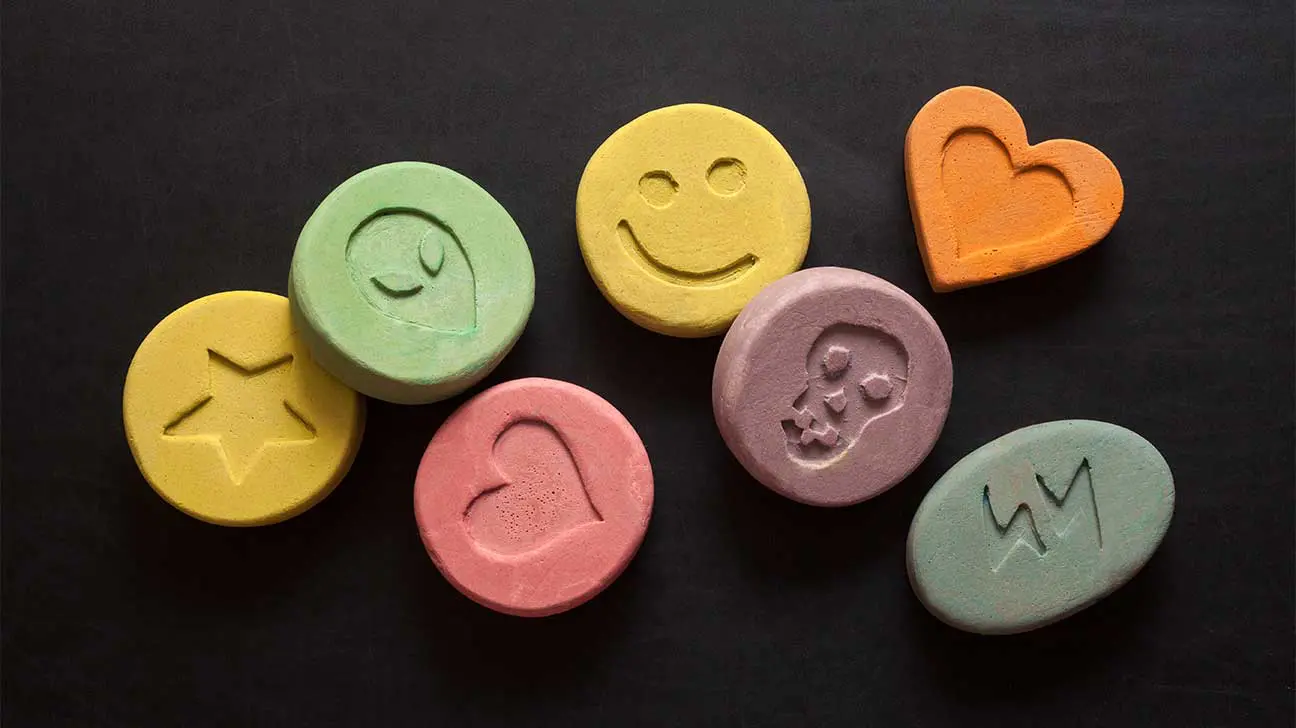
Molly (MDMA) and Sally (MDA) act as both stimulants and psychedelics. Because of this, they may cause a person to feel similar effects. Generally, people report feelings of closeness, euphoria, empathy, and sexuality when taking MDMA or MDA.
The key differences between the two drugs are that Sally may provide a more gradual yet intense high, may last slightly longer, and may cause more visual hallucinations.
Neither drug is approved by the FDA for medical purposes, which means people can’t get a prescription for them. Instead, MDMA and MDA are illicit drugs that are sold on the streets as a powder or pill.
Unfortunately, a person can never be entirely sure which drug they’re getting or if it’s been laced or cut with anything else. Because there’s no regulated dosing information, the risk of overdose is also increased with either drug.
What Is Molly (MDMA)?
Molly (MDMA) is also often sold as Ecstasy, or “X”. It’s a synthetic drug that became popular as a party drug in the 1980s for its reported effects.
Typically, Molly is sold as a tablet, capsule, powder, or liquid. It’s usually ingested orally, but Molly can also be snorted, smoked, or injected. It’s often abused alongside alcohol, marijuana, and LSD.
MDMA affects several neurotransmitters in the brain that control serotonin, norepinephrine, and dopamine production/reuptake. Unfortunately, messing with the balance of these chemicals can have potentially severe side effects.
Side Effects Of Molly (MDMA)
While MDMA may produce desired effects for three to six hours, the side effects that a person can experience up to a week afterward may range from uncomfortable to dangerous.
After the high from Molly wears off, a person may experience:
- irritability
- impulsiveness and aggression
- depression
- sleep problems
- anxiety
- memory and attention problems
- decreased appetite
- decreased interest in and pleasure from sex
If you’ve noticed these signs in yourself or a loved one, consider reaching out to a treatment specialist to talk about the possibility of MDMA abuse.
What Is Sally (MDA)?
Sally is another stimulant and psychedelic that can produce similar effects to those of Molly. While MDA isn’t as well-known, it may often be sold as Molly or Ecstasy since they look so similar.
Sally affects the same chemicals in the brain as Molly, including serotonin, norepinephrine, and dopamine.
People may experience the effects of Sally for six to eight hours. Additionally, they may experience more visual hallucinations compared to the “loving” high associated with MDMA.
Still, after the short-term desired effects of the drug wear off, many of the lasting negative effects can be the same as those described after using Molly.
Side Effects Of Sally (MDA)
After taking Sally, a person may experience an increased amount of energy, decreased appetite, nausea, dry mouth, sweating, and jaw clenching. While these effects may last up to eight hours, additional side effects can occur up to a week afterward.
Once the effects of Sally wear off, a person may experience any of the following side effects:
- anxiety
- depression
- confusion/memory loss
- headaches
- muscle stiffness
- convulsions
- trouble sleeping
- sexual problems
These side effects can be made worse if MDA is laced with or taken alongside other drugs.
Overdose Risks
It’s possible for a person to overdose on Molly or Sally. One of the biggest risks of overdose comes from not knowing exactly what a person is buying and taking. Both Molly and Sally are sold as pills or powder and may often be laced or cut with other drugs.
Specifically, the Drug Enforcement Administration (DEA) warns that illicit MDMA may contain methamphetamine, ketamine, or cocaine.
Even on their own, Molly and Sally both can lead to a risk of overdose. These drugs can interfere with the body’s ability to regulate temperature which can lead to an overdose in the form of hyperthermia, liver failure, kidney failure, or cardiovascular system failure.
Other Dangers Of Molly And Sally
Molly and Sally both affect neurotransmitters in the brain that help to regulate dopamine, serotonin, and norepinephrine.
While dopamine helps to balance the brain’s natural reward system, serotonin affects our mood, sleep, and appetite. Additionally, norepinephrine helps to regulate heart rate and blood pressure.
Causing an imbalance of any of these chemicals can lead to potentially severe side effects, including:
- new or worsening depression
- new or worsening anxiety
- insomnia
- changes in appetite or weight
- memory problems
Treatment Options For MDMA And MDA
If you or a loved one may be having problems with MDMA or MDA abuse, reach out to an addiction treatment specialist to determine the best course of action. Substance use disorders can be treated in a variety of treatment programs, such as inpatient treatment and outpatient programs.
In an inpatient treatment program, a person will go to a detox facility and stay for several weeks or months while they recover. Alternatively, in an outpatient treatment program, a person will visit a treatment center a few times each week and return home after receiving support and resources.
Whether you choose inpatient treatment or outpatient treatment, your recovery may include any or all of the following practices:
- individual or group therapy
- behavioral counseling
- rewards-based incentives
- evaluation and treatment for other mental health disorders
If you or a loved one are abusing MDMA or MDA, don’t put off getting help. Contact an AddictionResource.net treatment specialist today to find the best treatment facility and program for you.
Addiction Resource aims to provide only the most current, accurate information in regards to addiction and addiction treatment, which means we only reference the most credible sources available.
These include peer-reviewed journals, government entities and academic institutions, and leaders in addiction healthcare and advocacy. Learn more about how we safeguard our content by viewing our editorial policy.
- National Institute on Drug Abuse — Drugs, Brains, And Behavior: The Science Of Addiction
https://www.drugabuse.gov/publications/drugs-brains-behavior-science-addiction/drugs-brain - National Institute on Drug Abuse — MDMA (Ecstasy/Molly) DrugFacts
https://www.drugabuse.gov/publications/drugfacts/mdma-ecstasymolly - National Institute on Drug Abuse — MDMA (Ecstasy) Abuse Research Report
https://www.drugabuse.gov/publications/research-reports/mdma-ecstasy-abuse/Introduction - National Library of Medicine — Methylenedioxyamphetamine (MDA) And Methylenedioxymethamphetamine (MDMA) Cause Selective Ablation Of Serotonergic Axon Terminals In Forebrain: Immunocytochemical Evidence For Neurotoxicity
https://pubmed.ncbi.nlm.nih.gov/2457659/ - U.S. Department of Justice: Drug Enforcement Administration — Drugs Of Abuse
https://www.dea.gov/sites/default/files/drug_of_abuse.pdf

